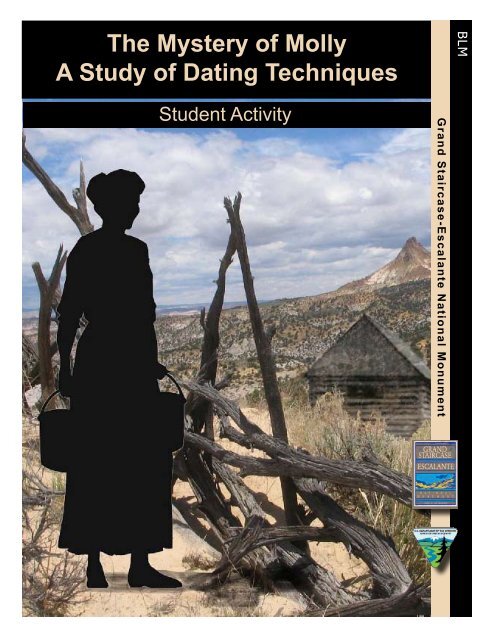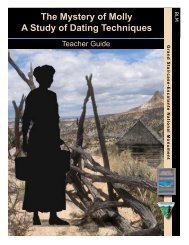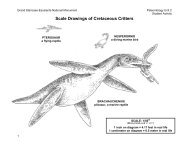The Mystery of Molly – A Study of Dating ... - gsenmschool.org
The Mystery of Molly – A Study of Dating ... - gsenmschool.org
The Mystery of Molly – A Study of Dating ... - gsenmschool.org
You also want an ePaper? Increase the reach of your titles
YUMPU automatically turns print PDFs into web optimized ePapers that Google loves.
<strong>The</strong> <strong>Mystery</strong> <strong>of</strong> <strong>Molly</strong><br />
A <strong>Study</strong> <strong>of</strong> <strong>Dating</strong> Techniques<br />
Student Activity<br />
Grand Staircase-Escalante National Monument<br />
BLM
Grand Staircase – Escalante National Monument Archaeology Unit 1<br />
Student Activity<br />
<strong>The</strong> <strong>Mystery</strong> <strong>of</strong> <strong>Molly</strong><br />
A <strong>Study</strong> <strong>of</strong> <strong>Dating</strong> Techniques<br />
Archaeologists and anthropologists, who study human cultures, <strong>of</strong>ten find themselves doing<br />
forensic science. When historic and prehistoric sites are excavated they need to be dated. In<br />
this activity you will learn about different dating methods and see how they would be applied<br />
to solve a fictional cold case.<br />
We begin this activity with a mystery, and a disclaimer. First, the disclaimer: <strong>The</strong> following story<br />
is a bald-faced lie. Names and dates have been randomly chosen and have absolutely no relationship to actual<br />
people or events.<br />
A Fictional Cold Case<br />
Our tale begins with an old ranch house<br />
in Glass Eye Canyon that burned to the<br />
ground in 1964. At that time the Bureau<br />
<strong>of</strong> Land Management, the agency that<br />
managed the area, decided that the<br />
charred timbers and stone rubble from<br />
the fireplace would be left untouched.<br />
Over the years the old ruin became a<br />
hazard, so the BLM sent a crew in to<br />
clean it up.<br />
In June 2004 two men were digging up<br />
an old watering system in an abandoned<br />
corral when they made an interesting discovery – not more than fifty feet from the burned<br />
down ranch house were more charred beams. <strong>The</strong>y dug a bit further, but stopped when they<br />
saw some bones and broken china. <strong>The</strong> crew leader decided it was time to call in<br />
archaeologists.<br />
When the archaeologists arrived they immediately started recording the site. Measurements<br />
were taken to determine the dimensions and depth <strong>of</strong> the new discovery. Every shovel <strong>of</strong><br />
dirt and debris was sifted. All items found were bagged and tagged while the depth and exact<br />
location <strong>of</strong> each find was carefully documented.<br />
Several old beams were excavated that appeared to be locally cut. Beneath the beams, on top<br />
<strong>of</strong> the burned wood floor, was an entire skeleton. <strong>The</strong> skeleton was charred but mostly<br />
intact. Scattered around on the burned floor was more broken china. Just under the burned<br />
floor in a shallow hole scraped in the ground, a twelve inch square metal box was unearthed.<br />
<strong>The</strong> bottom <strong>of</strong> the metal box bore an inscription <strong>of</strong> a manufacturer’s date <strong>of</strong> 1883.<br />
1
Grand Staircase – Escalante National Monument Archaeology Unit 1<br />
Student Activity<br />
Analysis <strong>of</strong> the bones and teeth indicated that the skeleton was that <strong>of</strong> a female in her late<br />
20’s or early 30’s. Her skull had been crushed near the left temple. <strong>The</strong> china had a distinct<br />
old English pattern <strong>of</strong> roses and butterflies.<br />
When the metal box was opened a smaller wooden box was found inside. <strong>The</strong> box was filled<br />
with old letters, all addressed to <strong>Molly</strong>. <strong>The</strong> letters were dated between 1884 and 1887.<br />
Several <strong>of</strong> the letters were signed by “Robert Parker.” Other letters were signed with only<br />
the first names <strong>of</strong> Tom, Dick, and Harry.<br />
To solve mysteries like the <strong>Mystery</strong> <strong>of</strong> <strong>Molly</strong>, scientists have several different techniques, or<br />
methods that help them date sites and artifacts. <strong>The</strong>se different methods are classified into<br />
two categories: Absolute and Relative dating.<br />
Absolute <strong>Dating</strong><br />
<strong>The</strong>re are many different methods <strong>of</strong> absolute dating including: chronological markers,<br />
dendrochronology, radiocarbon dating, thermoluminescence, obsidian-hydration, and<br />
potassium-argon dating.<br />
• Potassium-argon dating is not used to date archaeological sites in the New World<br />
because there are no sites old enough. Potassium-argon dates volcanic material and<br />
is useful for sites dated between 50,000 and 2 billion years ago.<br />
• <strong>The</strong>rmoluminescence is based on the fact that electrons in mineral emit light, or<br />
luminesce, when they are heated. <strong>The</strong>rmoluminescence is used to date ceramics that<br />
are 300 to 100,000 years old.<br />
• Obsidian-hydration dates obsidian tools and flakes resulting from the process <strong>of</strong> flintknapping.<br />
Archaeologists don’t <strong>of</strong>ten use obsidian-hydration dating because there are<br />
many variables and not enough accuracy.<br />
<strong>The</strong> three methods scientists would probably use with the evidence in the story <strong>of</strong> <strong>Molly</strong> are<br />
chronological markers, dendrochronology, and radiocarbon dating. <strong>The</strong>se methods are<br />
described on the following pages. Read the information about each <strong>of</strong> them and determine<br />
how they would apply to the <strong>Mystery</strong> <strong>of</strong> <strong>Molly</strong>.<br />
Chronological Markers<br />
Step 1: Read about chronological markers<br />
Chronological markers include objects or artifacts that have<br />
specific dates inscribed or printed on them. Coins,<br />
tombstones, newspapers, and written documents with dates<br />
are all chronological markers.<br />
Designs or photos can also be chronological markers. Every<br />
Olympics has a different logo that can be used to date that<br />
specific event. Photos may have dates in them, like those<br />
taken <strong>of</strong> people holding newspapers. Photos can also depict<br />
specific events in history, like the raising <strong>of</strong> the flag by<br />
Marines at Iwo Jima on February 23, 1945.<br />
2
Grand Staircase – Escalante National Monument Archaeology Unit 1<br />
Student Activity<br />
Step 2: Apply chronological markers to the mystery <strong>of</strong> <strong>Molly</strong><br />
Question 1<br />
Which <strong>of</strong> the artifacts unearthed by archaeologists would be chronological markers?<br />
________________________________________________________________________<br />
________________________________________________________________________<br />
________________________________________________________________________<br />
________________________________________________________________________<br />
Question 2<br />
<strong>The</strong> pattern on the broken pottery was traced to a company in England that made china<br />
from 1752-1882 and sold the pattern found at the dig for twelve years, from 1860-1872.<br />
Would this be a chronological marker? If so, what information would this give you about the<br />
cold case?<br />
________________________________________________________________________<br />
________________________________________________________________________<br />
________________________________________________________________________<br />
________________________________________________________________________<br />
For more information about chronological markers visit this web site:<br />
http://archaeology.about.com/cs/datingtechniques/a/timing_2.htm<br />
Dendrochronology<br />
Step 1: Investigate dendrochonology<br />
Dendrochronology is also called tree-ring<br />
dating. Tree-ring dating is based on the<br />
growth rings <strong>of</strong> trees which vary with seasonal<br />
and annual precipitation and temperature.<br />
Trees <strong>of</strong> the same species growing in the same<br />
area will have matching growth ring patterns<br />
for the period <strong>of</strong> time during which they were<br />
both alive.<br />
By taking a core sample from a tree, or by<br />
taking an entire cross section <strong>of</strong> the tree trunk<br />
when it’s cut down, scientists can match the<br />
growth rings to samples stored in<br />
museums and laboratories and learn how<br />
old the tree is and what weather<br />
patterns were like during the tree’s lifetime.<br />
3
Grand Staircase – Escalante National Monument Archaeology Unit 1<br />
Student Activity<br />
Dendrochronology can be used to date structures built with wood, especially if there are<br />
large beams. Scientists can core the beams and then compare the rings to tree ring data<br />
collected in the same area. <strong>The</strong>y can use this information to determine when the tree was cut<br />
down and therefore when the structure was built.<br />
<strong>The</strong>re is a great slide show about dendrochronology at the following web site:<br />
History Detectives – Timber <strong>Dating</strong><br />
http://www.pbs.<strong>org</strong>/opb/historydetectives/techniques/timber.html<br />
Step 2: Apply dendrochonology to the mystery <strong>of</strong> <strong>Molly</strong><br />
Question 3<br />
A few <strong>of</strong> the beams were in good enough condition that they were sent to the<br />
dendrochronology lab. Scientists in the lab matched the growth rings <strong>of</strong> the charred beams<br />
to charts made from other trees in the region. <strong>The</strong> tree had been cut down in 1880. What<br />
does this information tell you about the excavated house?<br />
________________________________________________________________________<br />
________________________________________________________________________<br />
________________________________________________________________________<br />
________________________________________________________________________<br />
For more information about Dendrochronology visit these web sites:<br />
Dendrochronology <strong>of</strong> Bristle Cone Pines<br />
http://www.sonic.net/bristlecone/dendro.html<br />
Tree Ring <strong>Dating</strong><br />
http://waynesword.palomar.edu/treedate.htm<br />
Chronometric Techniques – Dendrochronology<br />
http://anthro.palomar.edu/time/time_4.htm<br />
Radiocarbon <strong>Dating</strong><br />
Step 1: Investigate radiocarbon dating<br />
Radiocarbon dating is based on the fact that all living <strong>org</strong>anisms<br />
are carbon-based. Everything that has ever lived has carbon in it.<br />
In fact, anything that has ever lived has not one, but two forms <strong>of</strong><br />
carbon in it.<br />
Carbon 14 (C14) is a radioactive element found in both the<br />
atmosphere and in living <strong>org</strong>anisms. When an <strong>org</strong>anism is alive,<br />
the amount <strong>of</strong> C14 in that <strong>org</strong>anism is the same as the C14 in the<br />
atmosphere. When a living <strong>org</strong>anism dies it stops taking in C14<br />
and the element begins to decay.<br />
4
Grand Staircase – Escalante National Monument Archaeology Unit 1<br />
Student Activity<br />
<strong>The</strong> half-life rate <strong>of</strong> C14 is 5,730 years. This means that it takes 5,730 years for half <strong>of</strong> the<br />
C14 that was in the <strong>org</strong>anism when it was alive to decay. Comparing the amount <strong>of</strong> C14 in a<br />
dead <strong>org</strong>anism to atmospheric levels provides an estimate <strong>of</strong> when it died. C14 can be used<br />
reliably for about ten half-lives, or 57,000 years.<br />
Radiocarbon dating can be used on charcoal, wood, shells, bone, antlers, peat, and nearly<br />
anything else that contained carbon in its life cycle.<br />
Questions about the use <strong>of</strong> radiocarbon dating have been raised because atmospheric levels<br />
<strong>of</strong> C14 have fluctuated from time to time in Earth’s history. Extensive burning <strong>of</strong> fossil fuels<br />
at the start <strong>of</strong> the Industrial Revolution resulted in an increase in atmospheric C14. <strong>The</strong> use<br />
<strong>of</strong> fossil fuels today is affecting levels <strong>of</strong> C14, but scientists are keeping accurate records so<br />
radiocarbon dating can be used on more recent objects.<br />
An interesting development in radiocarbon dating has been the correlation <strong>of</strong> tree-ring<br />
dating with radiocarbon dates. When dates from tree-ring patterns and the date from<br />
radiocarbon dating <strong>of</strong> the same tree sample correlate, scientists can verify both the tree-ring<br />
and C14 dates. As with all science, the more samples you can test the better.<br />
If you need some help understanding radiocarbon dating try this web site:<br />
<strong>The</strong> <strong>Dating</strong> Game<br />
http://www.pbs.<strong>org</strong>/wgbh/nova/first/radiocarbon.html<br />
Step 2: Apply radiocarbon dating to the mystery <strong>of</strong> <strong>Molly</strong><br />
Question 4<br />
Charcoal from the burned wood in the house was sent to a radiocarbon dating lab for<br />
analysis. <strong>The</strong> radiocarbon date <strong>of</strong> the charcoal came back from the lab as 1887, +/- five<br />
years. What does this date tell you about the excavated house?<br />
________________________________________________________________________<br />
________________________________________________________________________<br />
________________________________________________________________________<br />
________________________________________________________________________<br />
For more information about radiocarbon dating visit this web site:<br />
Chronometric Techniques – Radiocarbon <strong>Dating</strong><br />
http://anthro.palomar.edu/time/time_5.htm<br />
5
Grand Staircase – Escalante National Monument Archaeology Unit 1<br />
Student Activity<br />
Relative <strong>Dating</strong><br />
Relative dating doesn’t yield precise dates but it does put historic sites and artifacts into a<br />
time frame <strong>of</strong> “older and newer.” Two methods <strong>of</strong> relative dating are stratigraphy and<br />
seriation. Read the information about each <strong>of</strong> them and determine how they would apply to<br />
the mystery <strong>of</strong> <strong>Molly</strong>.<br />
Stratigraphy<br />
Step 1: Investigate stratigraphy<br />
Stratigraphy is based on the Law <strong>of</strong> Superposition which states that younger strata will be<br />
deposited on top <strong>of</strong> strata that are older. So stratigraphy is the study <strong>of</strong> sediment strata, or<br />
layers, and how these strata came to be the way they are now.<br />
Where specific artifacts are found in sediment strata is a good indicator <strong>of</strong> how old, or new,<br />
they are. For example, if a piece <strong>of</strong> pottery is found .5 meters (20 inches) below the soil<br />
surface and another piece <strong>of</strong> pottery is found at 1.5 meters (59 inches) below the surface,<br />
survey says that the potsherd from 1.5 meters is older than the potsherd from .5 meters.<br />
Makes perfect sense, doesn’t it?<br />
Step 2: Apply stratigraphic analysis to the mystery <strong>of</strong> <strong>Molly</strong><br />
Question 5<br />
<strong>The</strong> second burned house was unearthed about .3 meters below the soil surface.<br />
Archaeologists recorded <strong>Molly</strong>’s remains under .5 meters <strong>of</strong> soil. <strong>The</strong> charred timbers and<br />
pottery were unearthed within five centimeters <strong>of</strong> that depth. <strong>The</strong> metal box was found at a<br />
depth <strong>of</strong> 1 meter. What do the different depths <strong>of</strong> artifacts and <strong>Molly</strong>’s bones tell you about<br />
this historic site?<br />
________________________________________________________________________<br />
________________________________________________________________________<br />
________________________________________________________________________<br />
________________________________________________________________________<br />
Question 6<br />
What does the depth <strong>of</strong> the metal box mean?<br />
________________________________________________________________________<br />
________________________________________________________________________<br />
________________________________________________________________________<br />
________________________________________________________________________<br />
6
Grand Staircase – Escalante National Monument Archaeology Unit 1<br />
Student Activity<br />
Seriation<br />
Step 1: Investigate seriation<br />
Seriations are also called artifact sequences. When archaeologists study potsherds they record<br />
variations in composition, shape, style, and decoration. This information forms the basis for<br />
developing seriations that chronicle artifact evolution over hundreds or thousands <strong>of</strong> years.<br />
Pottery, like fashion, changes over time.<br />
Step 2: Apply seriation to the mystery <strong>of</strong> <strong>Molly</strong><br />
Question 7<br />
Pottery was found at the site and the pattern was traceable, as you already learned in the<br />
discussion <strong>of</strong> chronological markers. Could this broken pottery be used in seriation and as a<br />
chronological marker? Explain your answer.<br />
________________________________________________________________________<br />
________________________________________________________________________<br />
________________________________________________________________________<br />
________________________________________________________________________<br />
________________________________________________________________________<br />
<strong>The</strong> Final Step<br />
So who was <strong>Molly</strong>?<br />
Throughout the southwest desert there are<br />
geologic features named after someone<br />
named <strong>Molly</strong>. Could this be her?<br />
How did she die?<br />
Was <strong>Molly</strong> murdered?<br />
Could jealousy have been a motive?<br />
Why were her remains left in the burned rubble?<br />
Was she tragically killed in a fire with no<br />
loved ones around to retrieve her bones for<br />
burial?<br />
Why was another ranch house built so close?<br />
To hide a murder?<br />
Since this is a fictional story there is no answer. That’s up to you.<br />
7<br />
<strong>Molly</strong>’s Nipple<br />
Grand Staircase-Escalante National Monument
Grand Staircase – Escalante National Monument Archaeology Unit 1<br />
Student Activity<br />
Question 8<br />
In the space below, and on another piece <strong>of</strong> paper if needed, write your hypothesis and<br />
conclusion about the life and death <strong>of</strong> <strong>Molly</strong>, if indeed she really was <strong>Molly</strong>. Use the<br />
information obtained through the use <strong>of</strong> absolute and relative dating techniques to back up<br />
your hypothesis.<br />
________________________________________________________________________<br />
________________________________________________________________________<br />
________________________________________________________________________<br />
________________________________________________________________________<br />
________________________________________________________________________<br />
________________________________________________________________________<br />
________________________________________________________________________<br />
________________________________________________________________________<br />
________________________________________________________________________<br />
________________________________________________________________________<br />
________________________________________________________________________<br />
________________________________________________________________________<br />
________________________________________________________________________<br />
________________________________________________________________________<br />
________________________________________________________________________<br />
________________________________________________________________________<br />
________________________________________________________________________<br />
________________________________________________________________________<br />
________________________________________________________________________<br />
________________________________________________________________________<br />
________________________________________________________________________<br />
________________________________________________________________________<br />
________________________________________________________________________<br />
________________________________________________________________________<br />
________________________________________________________________________<br />
________________________________________________________________________<br />
________________________________________________________________________<br />
8
Grand Staircase – Escalante National Monument Archaeology Unit 1<br />
Student Activity<br />
Vocabulary:<br />
Archaeologist One who studies past human life and culture by the<br />
recovering and examination <strong>of</strong> remaining material<br />
evidence, such as graves, buildings, tools, and pottery.<br />
Anthropologist One who studies the origin, the behavior, and the physical,<br />
social, and cultural development <strong>of</strong> humans.<br />
Flint-knapping <strong>The</strong> activity, largely carried out by prehistoric people, <strong>of</strong><br />
chipping and splitting flint to make tools.<br />
Obsidian A jet-black volcanic glass, chemically similar to granite and<br />
formed by the rapid cooling <strong>of</strong> molten lava, that was used<br />
by early civilizations for manufacturing tools and ceremonial<br />
objects.<br />
Seriation Arrangement or position in a series.<br />
Stratigraphy <strong>The</strong> study <strong>of</strong> rock strata, especially the distribution,<br />
deposition, and age <strong>of</strong> sedimentary rocks.<br />
9





